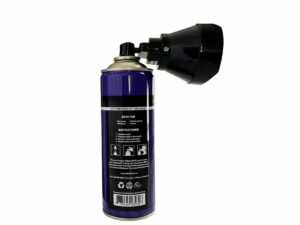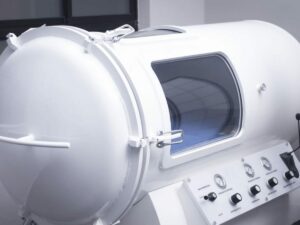Why do football players use oxygen? In the high-intensity world of football, players often turn to supplemental oxygen for recovery and performance enhancement.
As a seasoned expert in hyperbaric chambers and oxygen therapy, my extensive experience offers valuable insights into the application of oxygen in sports medicine and athlete recovery.
In this article, we will delve into the science behind oxygen use in football, exploring its impact on performance, recovery, and overall athlete well-being.
Keep reading to learn more!
1. The Science of Oxygen in Sports
Oxygen plays a critical role in sports, acting as a key element for energy production and endurance. Normally, an optimal blood oxygen level must typically fall within the range of 95–100%, according to Healthline. Essentially, the more efficiently the body uses oxygen, the better they perform and the quicker they recover.
Here’s the interesting part, the science behind oxygen use in sports extends beyond simple inhalation. It involves optimizing the body’s oxygen uptake and utilization to enhance athletic performance and recovery. Techniques such as hyperbaric oxygen therapy can significantly increase the amount of oxygen dissolved in the blood, thereby speeding up recovery processes and reducing fatigue.
2. Benefits of Oxygen for Football Players
Building on the science of oxygen in sports, we explored how oxygen supplementation can significantly enhance athletic performance and recovery. Here are the benefits of oxygen for football players:
Improved Performance Durability
Oxygen supplementation enables football players to maintain peak performance for longer durations during a game. By enhancing oxygen delivery to the muscles, players experience a boost in their endurance levels, allowing them to execute high-intensity plays with less fatigue. This not only maximizes their time on the field but also ensures that their performance does not dip as the game progresses.
Enhanced Cognitive Function
The brain’s oxygen demand increases during high-stakes moments, affecting decision-making and focus. Supplemental oxygen can sharpen a player’s cognitive functions, improving their reaction times, strategic thinking, and overall mental clarity on the field. This mental edge can be the difference between winning and losing, especially in closely contested matches.
Reduced Injury Risk
Consistent oxygen use can help mitigate the risk of injuries by ensuring that muscles and tissues receive ample oxygen to function correctly. This preventive measure keeps muscles flexible and less prone to tears and strains. How awesome is that? Beyond the physical benefits, this aspect provides players with peace of mind, knowing their risk of injury is minimized, allowing them to play freely and with confidence.
3. Types of Oxygen Delivery Systems for Football Players
Following the discussion on the benefits of oxygen for football players, it’s clear that oxygen plays a pivotal role in enhancing performance and recovery. Here are the types of oxygen delivery systems football players can utilize:
Portable Oxygen Cans
These lightweight, easy-to-carry oxygen cans are perfect for quick, on-the-spot oxygen supplementation on the sidelines. Players can take a few deep breaths from these cans during breaks, helping to rapidly increase their oxygen levels, which can boost endurance and recovery during critical moments of the game. This method is highly efficient and user-friendly, making it a popular choice among athletes.

Hyperbaric Oxygen Therapy Chambers
HBOT chambers are used for deep recovery sessions just like what Oxygen-Ark is offering. By providing oxygen at higher than atmospheric pressures, these chambers enhance the body’s natural healing processes, significantly improving recovery times from injuries and reducing inflammation. The therapy is not just about immediate recovery, it’s a long-term investment in a player’s health and performance sustainability.

Demand Valve Oxygen Therapy
This system delivers oxygen only when the athlete inhales, reducing wastage and ensuring a concentrated dose is delivered directly to the lungs. It’s particularly beneficial for immediate recovery post-exertion, offering a quick and effective way to replenish oxygen levels. And the best part is, it’s tailored for efficiency, ensuring players get the exact amount of oxygen they need, when they need it.

4. The Process of Oxygen Supplementation in Football Players
After exploring the various types of oxygen delivery systems for football players, it’s clear that incorporating oxygen supplementation into a player’s routine is a strategic process. Here are the steps involved in the process of oxygen supplementation for football players:
Step#1 Pre-Game Oxygenation
Many players begin their oxygen supplementation before the game even starts, using portable oxygen cans or masks to saturate their bodies with oxygen. This pre-loading technique ensures their muscles are oxygen-rich, enhancing their stamina and readiness from the first whistle. It sets a solid foundation for peak performance, preparing the body to operate efficiently under the strenuous demands of the game.
Step#2 In-Game Supplementation
During the game, players often utilize brief moments on the sidelines for quick hits of oxygen from portable cans or masks. This immediate replenishment helps maintain high oxygen levels in the blood, supporting sustained energy output and reducing the buildup of lactic acid. In moments where every second counts, this quick boost can be a game-changer, allowing players to return to the field properly.
Step#3 Post-Game Recovery
After the game, oxygen therapy shifts towards recovery, with players using masks connected to oxygen concentrators or spending time in hyperbaric oxygen therapy chambers. This phase focuses on repairing the muscles and tissues stressed during the game, accelerating the recovery process by increasing oxygen flow to the damaged areas. It’s a critical step in ensuring players are in top condition for their next performance.
Step#4 Routine Oxygen Therapy Sessions
Beyond immediate pre- and post-game use, players often engage in regular oxygen therapy sessions as part of their training regimen. These sessions are tailored to enhance long-term health and performance. And the best part is, it is not only boosts their physical capabilities but also strengthens their resilience against future injuries.

5. Oxygen Therapy vs. Oxygen Supplementation
Following the detailed exploration of the process of oxygen supplementation in football players, I do believe that it becomes evident that there’s a nuanced distinction between oxygen therapy and oxygen supplementation. Here are the key differences:
Purpose and Application:
- Oxygen Therapy: Use for recovery and rehabilitation, targeting injury treatment and healing, especially in the form of HBOT, using quality chambers is always top-tier and for that I recommend Oxygen-Ark.
- Oxygen Supplementation: Refers to the use of oxygen for immediate performance enhancement and fatigue reduction during and shortly before or after athletic events.
Delivery Method and Concentration:
- Oxygen Therapy: Often involves the use of specialized equipment such as HBOT chambers, which can deliver 100% oxygen at pressures greater than sea level atmospheric pressure.
- Oxygen Supplementation: Typically uses portable oxygen cans or masks that deliver a lower concentration of oxygen, tailored for quick absorption and immediate effect on performance or recovery.
Regularity and Duration:
- Oxygen Therapy: Sessions are usually scheduled regularly as part of a comprehensive treatment plan for injury recovery, with each session lasting anywhere from 60 to 90 minutes.
- Oxygen Supplementation: It is utilized on an as-needed basis, with athletes taking short bursts of oxygen before, during, or after events to rapidly boost oxygen levels.
Scientific and Medical Oversight:
- Oxygen Therapy: HBOT and other forms of oxygen therapy typically require medical oversight, given their application for therapeutic and rehabilitation purposes.
- Oxygen Supplementation: While still benefiting from professional guidance, it can be administered with more flexibility and autonomy by the athletes themselves or their support teams.
6. Controversies and Myths Surrounding Oxygen Use in Sports
Following our dive into the nuances between oxygen therapy vs. oxygen supplementation, it’s apparent that while these practices offer numerous benefits to athletes, they are not without their controversies and myths. Here are some of the most common misconceptions and debates:
More Oxygen Always Means Better Performance
A common myth is that the more oxygen an athlete uses, the better their performance will be. In reality, the body can only utilize a certain amount of supplemental oxygen efficiently. Beyond a specific point, additional oxygen does not translate to further performance improvements and can disrupt the body’s natural oxygen homeostasis.
Oxygen Therapy Can Completely Prevent Injuries
Another myth suggests that oxygen therapy can entirely prevent sports injuries. While oxygen therapy significantly aids in recovery and can reduce the risk of certain injuries by improving muscle and tissue health, it cannot completely prevent injuries. I still believe that proper training, for example warm-up routines, and physical care, are the best in injury prevention strategies.
All Athletes Can Benefit Equally from Oxygen Supplementation
The belief that oxygen supplementation is universally beneficial for all athletes regardless of sport, condition, or individual health needs is misleading. The effectiveness of oxygen supplementation and therapy varies based on the athlete’s specific health conditions, the intensity of their sport, and their body’s unique response to oxygen. Tailoring oxygen use to the athlete’s specific needs is crucial for maximizing its benefits.
| Factor |
Description |
| Athlete’s Health Conditions |
Certain health conditions may affect an athlete’s ability to utilize oxygen effectively, such as asthma, COPD, or cardiovascular issues. |
| Sport Intensity |
The intensity and duration of the sport can impact the demand for oxygen, with higher intensity activities requiring more oxygen supplementation. |
| Individual Response to Oxygen |
Each athlete responds differently to oxygen supplementation, influenced by factors like genetics, training adaptations, and metabolic efficiency. |
| Altitude |
Athletes training or competing at high altitudes may benefit from supplemental oxygen due to decreased oxygen availability in the atmosphere. |
| Training Environment |
Environmental factors such as temperature, humidity, and pollution levels can affect oxygen utilization and the need for supplementation during training sessions. |
7. 3 Practical Tips for Oxygen Use in Football
Navigating through the controversies and myths surrounding oxygen use in sports reveals its significant benefits, especially in football. Amazing right? Here are practical tips for integrating oxygen use effectively within football training and recovery routines:
#1 30 Minutes Pre-Game Oxygen Saturation
Begin oxygen supplementation before kickoff. For example, 30 minutes before the game starts, the player uses a portable oxygen device set to deliver 95% pure oxygen. They breathe in the oxygen through a mask for 5-minute intervals, taking short breaks between each session.
#2 Altitudes Above 2,500 Meters (8,200 Feet)
At this elevation, the air contains significantly less oxygen, which can affect stamina, strength, and overall game performance. To counteract these effects, start adjusting to high altitudes by training at similar elevations at least 2 weeks before competition, if possible.
#3 Pulse Oximetry
Utilize a pulse oximetry to continuously monitor the oxygen saturation levels before, during, and after games or training sessions. Aim to keep the saturation levels in the optimal range (95-100%) for sea-level performance. Adjustments to the oxygen supplementation should be made based on these readings to ensure receiving enough oxygen to compensate for the high altitude.
Dive Deeper Into Our Resources
For some insightful reads, we’ve curated a list of recommended articles just for you:
Still haven’t found what you’re looking for? Don’t hesitate to contact us. We’re available around the clock to assist you.
Conclusion
As we’ve explored, the science behind oxygen is used in sports, offering athletes at all levels a tool to elevate their game and ensure they’re performing at their best when it matters most. Whether it’s through hyperbaric oxygen therapy or portable oxygen cans incorporating oxygen into an athlete’s regimen is a game-changer.
For those looking to maximize their performance and recovery strategies through advanced oxygen therapy solutions, Oxygen-Ark stands as a leading manufacturer of hyperbaric chambers. Contact us today for more information!




